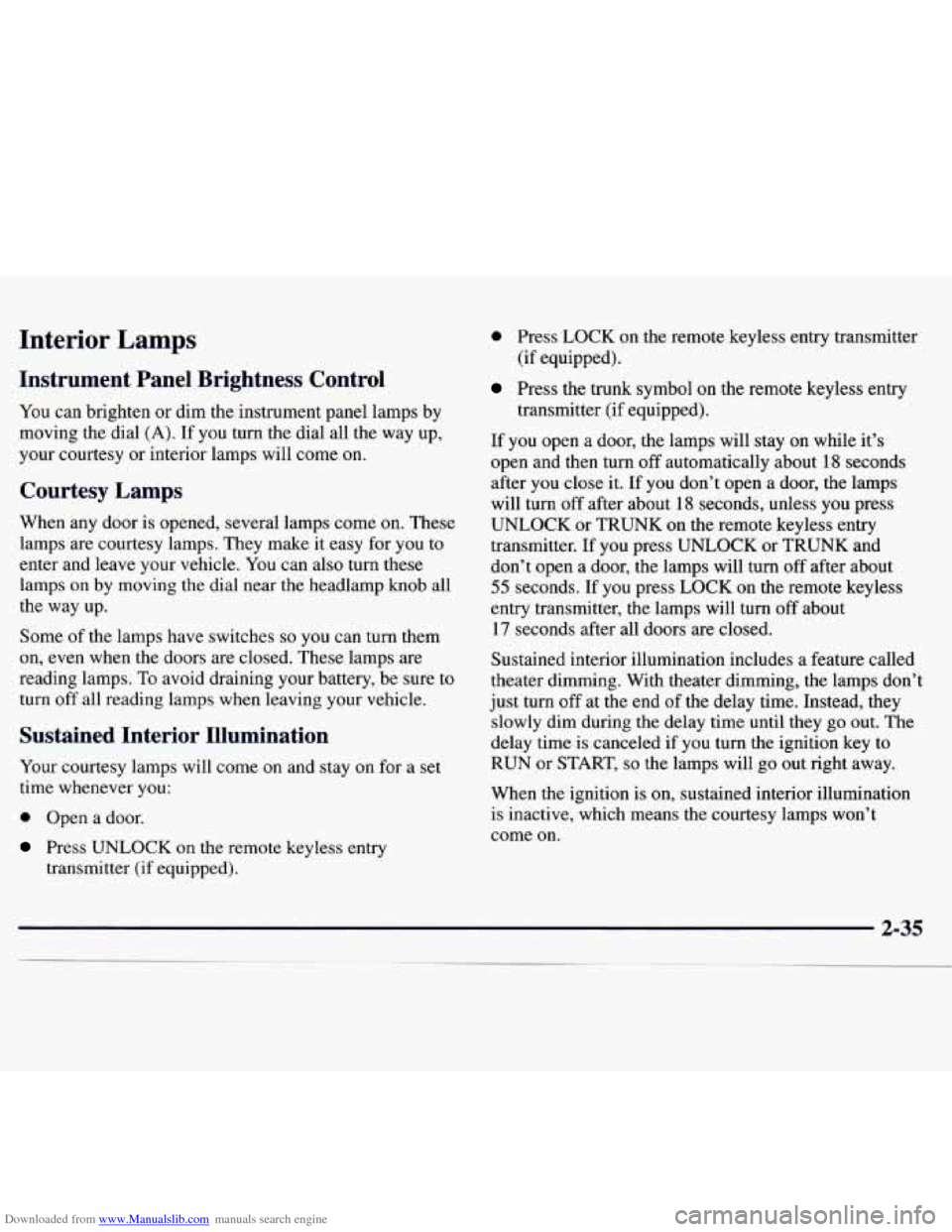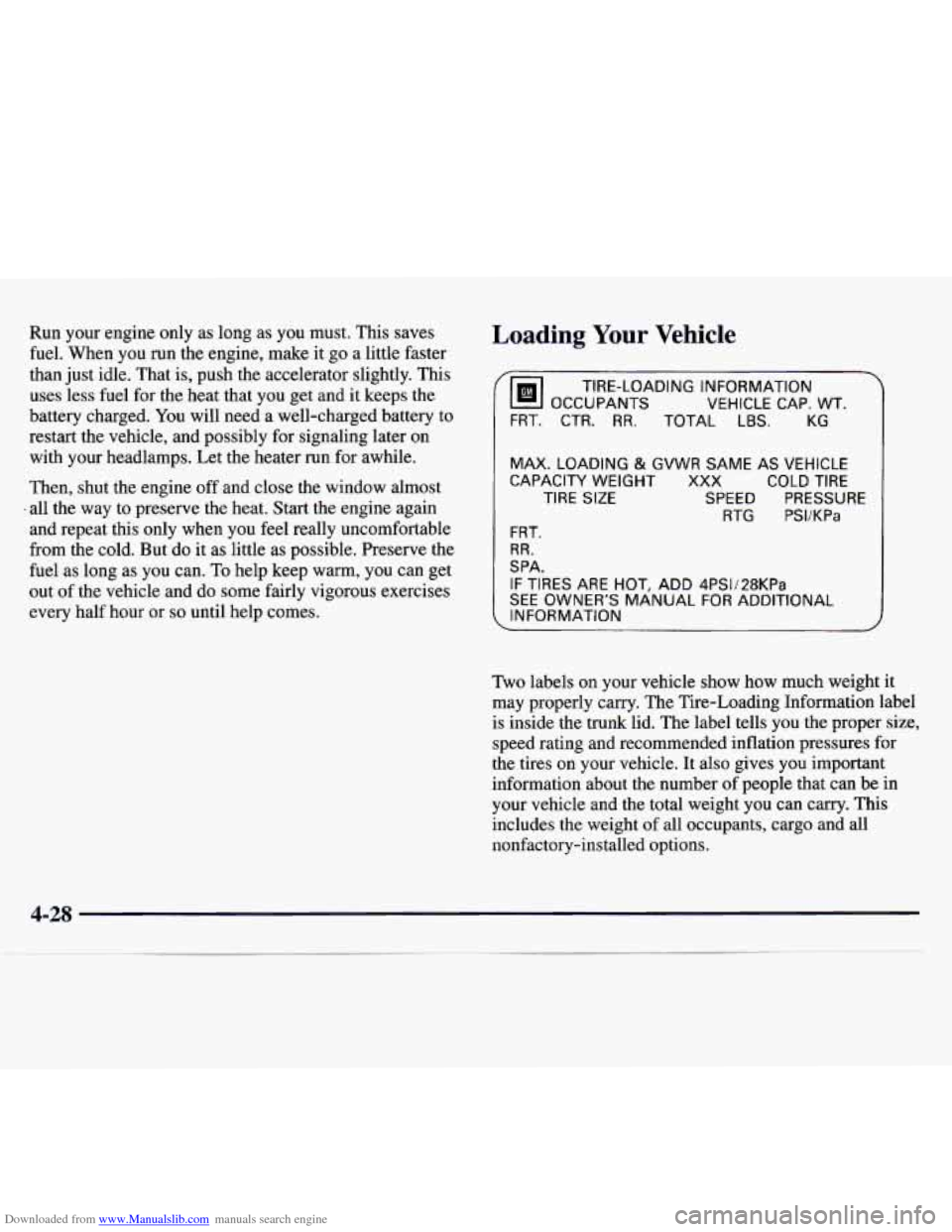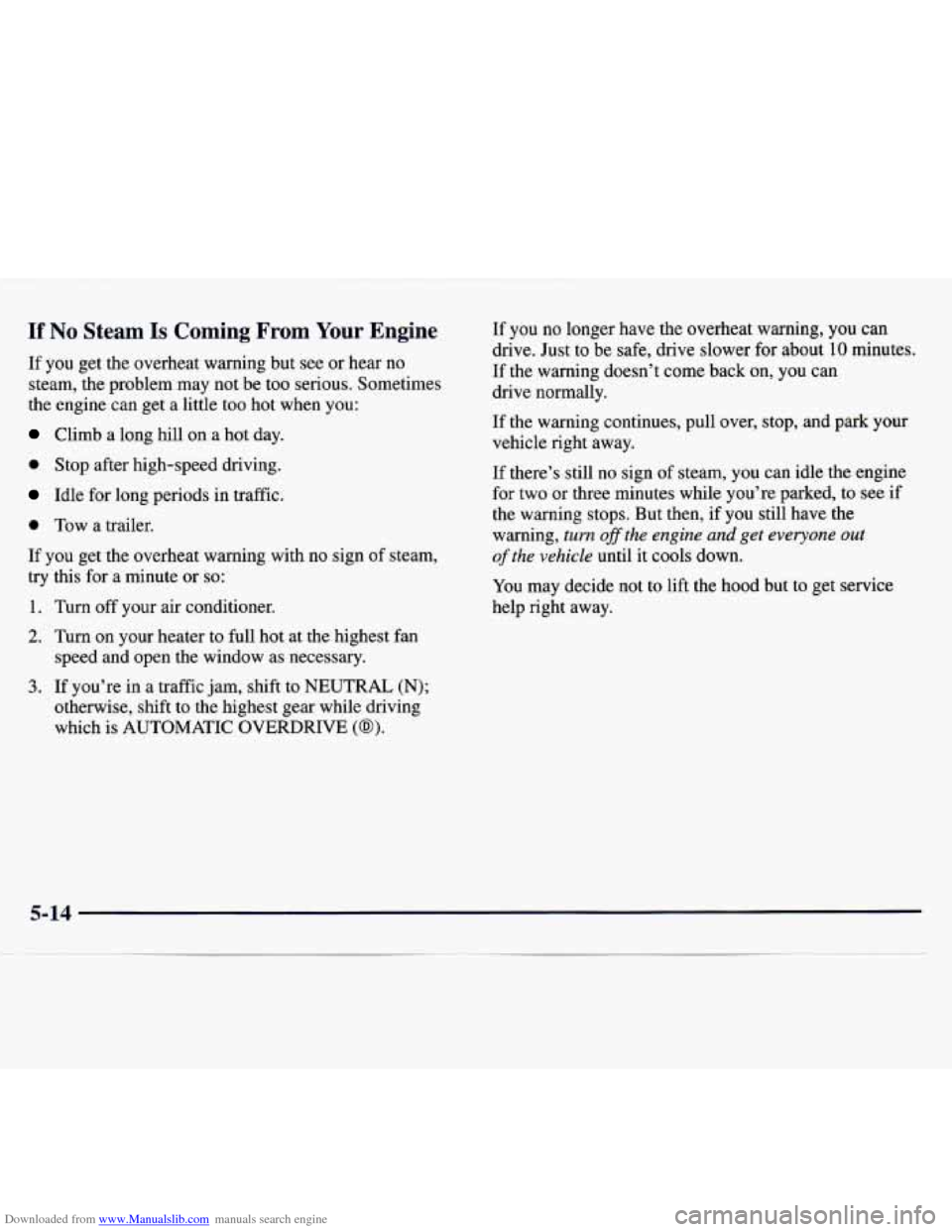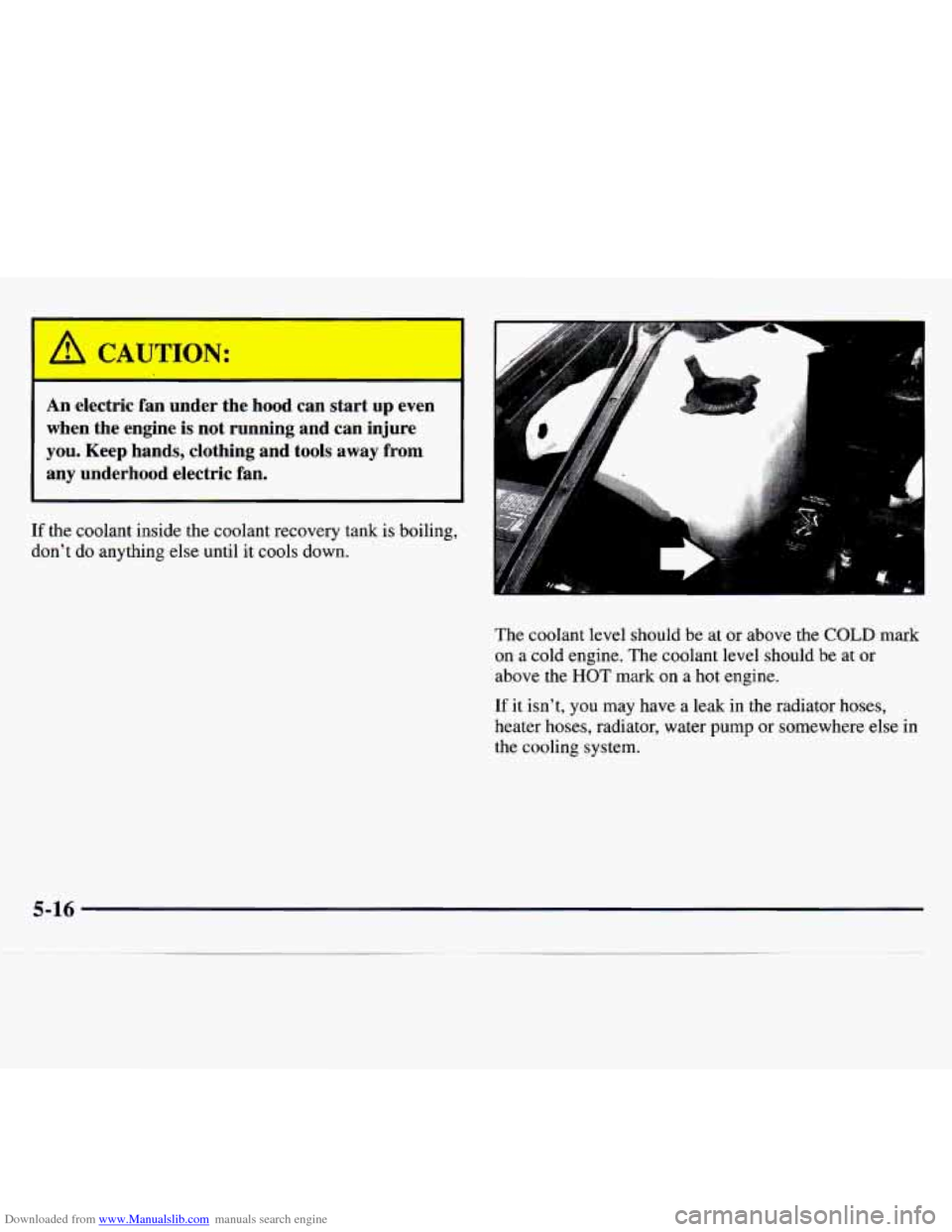1997 CHEVROLET MONTE CARLO heater
[x] Cancel search: heaterPage 60 of 358

Downloaded from www.Manualslib.com manuals search engine 0 Section 2 Features and Controls
Here you can learn about the many standard and optional features on your Chevrolet, and information on starting,
shifting and braking. Also explained are the instrument panel and
the warning systems that tell you if everything is
working properly -- and what to do if you have a problem.
2-2
2-4
2-5
2-8
2-9
2-10
2-12 2-12 2-13
2-15
2-16
2-20
2-2
I
2-24
2-24
2-25
2-25
Keys
Door Locks
Remote Keyless Entry (If Equipped)
Trunk
Theft PASS-Key@ I1
New Vehicle “Break-In”
Ignition Positions
Starting Your Engine
Engine Coolant Heater (Option)
Automatic Transaxle Operation
Parking Brake
Shifting Into PARK
(P)
Shifting Out of PARK (P)
Parking Over Things That Burn
Engine Exhaust
Running Your Engine While You’re Parked
2-26
2-27
2-27 2-27
2-33
2-35
2-36
2-3 8
2-40
2-40
2-42
2-43
2-44
2-46
2-48
Power Windows
Horn
Tilt Steering Wheel
Turn SignaVMultifunction Lever
Exterior Lamps Interior Lamps
Mirrors Storage Compartments
Ashtrays and Lighter
Sun Visors
Auxiliary Power Connection
Sunroof (Option)
Instrument Panel
-- Your
Information System
Instrument Panel Cluster
Warning Lights, Gages and Indicators
Page 74 of 358

Downloaded from www.Manualslib.com manuals search engine Engine Coolant Heater (Option) 3. Plug it into a normal, grounded 1 10-volt AC outlet.
I
Plugging the cord into an ungrounded outlet
could cause an electrical shock. Also, the wrong
kind of extension cord could overheat and cause
a fire. You could be seriously injured. Plug the
cord into a properly grounded three-prong
110-volt AC outlet.
If the cord won’t reach, use a
heavy-duty three-prong extension cord rated for
at least
15 amps.
In very cold weather, 0 OF (- 1 8 O C) or colder, the engine
coolant heater can help. You’ll get easier starting and
better fuel economy during engine warm-up. Usually,
the coolant heater should be plugged in a minimum of
four hours prior to starting your vehicle.
To Use the Coolant Heater
1. Turn off the engine.
2. Open the hood and unwrap the electrical cord, located
behind the vehicle’s passenger side headlamp fixture.
4. Before starting the engine, be sure to unplug
and store the cord as it was before to keep it away
from moving engine parts. If you
don’t, it could
be damaged.
How long should you keep the coolant heater plugged
in? The answer depends on the outside temperature, the
kind
of oil you have, and some other things. Instead of
trying to list everything here, we ask that you contact
your Chevrolet dealer in the area where you’ll be
parking your vehicle. The dealer can give you the best
advice for that particular area.
Page 94 of 358

Downloaded from www.Manualslib.com manuals search engine Interior Lamps
Instrument Panel Brightness Control
You can brighten or dim the instrument panel lamps by
moving the dial
(A). If you turn the dial all the way up,
your courtesy or interior lamps will come on.
Courtesy Lamps
When any door is opened, several lamps come on. These
lamps are courtesy lamps. They make
it easy for you to
enter and leave your vehicle. You can also turn these
lamps on by moving the dial near the headlamp knob all
the way up.
Some of the lamps have switches
so you can turn them
on, even when the doors are closed. These lamps are
reading lamps.
To avoid draining your battery, be sure to
turn off all reading lamps when leaving your vehicle.
Sustained Interior Illumination
Your courtesy lamps will come on and stay on for a set
time whenever you:
0 Open a door.
0 Press LOCK on the remote keyless entry transmitter
(if equipped).
Press the trunk symbol on the remote keyless entry
transmitter (if equipped).
If you open
a door, the lamps will stay on while it’s
open and then turn
off automatically about 18 seconds
after you close
it. If you don’t open a door, the lamps
will turn off after about
18 seconds, unless you press
UNLOCK or TRUNK on the remote keyless entry
transmitter. If you press UNLOCK or TRUNK and
don’t open a door, the lamps will turn off after about
55 seconds. If you press LOCK on the remote keyless
entry transmitter, the lamps will turn
off about
17 seconds after all doors are closed.
Sustained interior illumination includes a feature called
theater dimming. With theater dimming, the lamps don’t
just turn off
at the end of the delay time. Instead, they
slowly dim during the delay time until they go out. The
delay time is canceled if you turn the ignition key to
RUN or START,
so the lamps will go out right away.
When the ignition is on, sustained interior illumination
is inactive, which means the courtesy lamps won’t
come on.
Press UNLOCK on the remote keyless entry
transmitter (if equipped).
2-35
Page 123 of 358

Downloaded from www.Manualslib.com manuals search engine Air Conditioning Heating
On
very hot days, open the windows long enough to let
hot, inside air escape. This reduces the A/C compressor
load, which should help fuel economy.
For quick cool-down on very hot days, use MAX with
the temperature control all the way
in the blue area. If
this setting is used for long periods
of time, the air in
your vehicle may become too dry.
For normal cooling on hot days, use A/C with the
temperature control in the blue area. The system will
bring in outside air and cool it.
On cool but sunny days, the sun may warm your upper
body, but your lower body may not be warm enough.
You can use BI-LEVEL with the temperature control in
the middle. The system will bring in outside air and
direct
it to your upper body, while sending slightly
warmed air to your lower body. You may notice this
temperature difference more at some times than others. On cold days
use FLOOR with
the temperature control
all the way in the red area. The system will bring in
outside air, heat
it and send it to the floor ducts.
If your vehicle has an engine coolant heater, you can use
it to help your system provide warm air faster when it’s
cold outside
(0°F (-18°C) or lower). An engine coolant
heater warms the coolant your engine and heating
system use to provide heat. See “Engine Coolant
Heater”
in the Index.
Page 124 of 358

Downloaded from www.Manualslib.com manuals search engine Ventilation System
L
Adjust the direction of airflow by moving the
louvered vents.
Your vehicle’s flow-through ventilation system supplies
outside air into the vehicle when it is moving. Outside
air will also enter the vehicle when the air conditioning
fan is running.
Ventilation Tips
0
0
0
0
For mild outside temperatures when little heating or
cooling is needed,
use VENT to direct outside air
through your vehicle.
Keep the hood and front air inlet free
of ice, snow or
any other obstruction, such
as leaves. The heater and
defroster will work far better, reducing the chance
of
fogging the inside of your windows.
When you enter a vehicle in cold weather, set the
mode
to FLOOR and the fan to the highest speed for
a few moments before driving off. This helps clear
the intake ducts
of snow and moisture and reduces
the chance of fogging the inside of your windows.
Keep the air path under the front seats clear of
objects. This helps air to circulate throughout
your vehicle.
Defogging and Defrosting
Your system has two settings for clearing the front and
side windows.
To defrost the windows quickly, use
DEFROST with the temperature knob(s) all the way in
the red area.
To warm passengers while keeping the
windows clean, use
DEFOG.
3-5
Page 167 of 358

Downloaded from www.Manualslib.com manuals search engine Run your engine only as long as you must. This saves
fuel. When you
run the engine, make it go a little faster
than just idle. That is, push the accelerator slightly. This
uses less fuel for the heat that you get and it keeps the
battery charged. You will need a well-charged battery to
restart the vehicle, and possibly for signaling later
on
with your headlamps. Let the heater run for awhile.
Then, shut the engine off and close the window almost
. all the way to preserve the heat. Start the engine again
and repeat this only when you feel really uncomfortable
from the cold. But do it as little as possible. Preserve the
fuel as long as you can.
To help keep warm, you can get
out
of the vehicle and do some fairly vigorous exercises
every half hour or
so until help comes.
Loading Your Vehicle
ym OCCUPANTS VEHICLE CAP. WT.
TIRE-LOADING INFORMATION
FRT.
CTR. RR. TOTAL LBS. KG
MAX. LOADING & GVWR SAME AS VEHICLE
CAPACITY WEIGHT
XXX COLD TIRE
TIRE SIZE SPEED PRESSURE
RTG PSI/KPa
FRT.
RR.
SPA.
IF TIRES ARE HOT, ADD 4PS1/28KPa
SEE OWNER’S MANUAL FOR ADDITIONAL
INFORMATION
Two labels on your vehicle show how much weight it
may properly carry. The Tire-Loading Information label
is inside the
trunk lid. The label tells you the proper size,
speed rating and recommended inflation pressures for
the tires on your vehicle.
It also gives you important
information about
the number of people that can be in
your vehicle and
the total weight you can carry. This
includes the weight of all occupants, cargo and all
nonfactory-installed options.
4-28
Page 191 of 358

Downloaded from www.Manualslib.com manuals search engine If No Steam Is Coming From Your Engine
If you get the overheat warning but see or hear no
steam, the problem may not be too serious. Sometimes
the engine can get a little too hot when you:
Climb a long hill on a hot day.
0 Stop after high-speed driving.
Idle for long periods in traffic.
e Tow a trailer.
If you get the overheat warning with no sign of steam,
try this for a minute or
so:
1. Turn off your air conditioner.
2. Turn on your heater to full hot at the highest fan
speed and open the window as necessary.
3. If you’re in a traffic jam, shift to NEUTRAL (N);
otherwise, shift to the highest gear while driving
which is AUTOMATIC OVERDRIVE
(a).
If you no longer have the overheat warning, you can
drive. Just to be safe, drive slower for about
10 minutes.
If
the warning doesn’t come back on, you can
drive normally.
If the warning continues, pull over, stop, and park your
vehicle right away.
If there’s still no sign of steam, you can idle the engine
for two or three minutes while you’re parked, to see if
the warning stops. But then, if you still have the
warning,
turn ofthe engine and get everyone out
of the vehicle until it cools down.
You may decide not to lift the hood but to get service
help right away.
5-14
Page 193 of 358

Downloaded from www.Manualslib.com manuals search engine An electric fan under the hood can start up even
when the engine is not running and can injure
you. Keep hands, clothing and tools away from
any underhood electric fan.
If the coolant inside the coolant recovery tank is boiling,
don't do anything else until it cools down.
The coolant level should be at or above the
COLD mark
on
a cold engine. The coolant level should be at or
above the
HOT mark on a hot engine.
If it isn't, you may have a leak in the radiator hoses,
heater hoses, radiator, water
pump or somewhere else in
the cooling system.